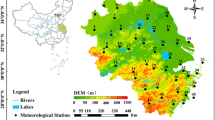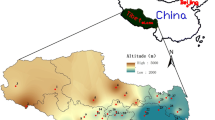Abstract
Accurate estimation of reference evapotranspiration (ET0) is an essential requirement for water resource management and scheduling agricultural activities. Several empirical methods have been employed in estimating ET0 across diverse climate regimes over the past decades. In this study, the Python implementation for estimation of daily and monthly ET0 values of representative stations of ten agro-climatic zones of Karnataka from 1979 to 2014 using the standard FAO Penman-Monteith method was carried out. The assessment of temporal and spatial variability of monthly ET0 values across the various agro-climatic zones done by the various statistical measures revealed that the variation in spatial ET0 values was higher than temporal variation, indicating major difference in ET0 values was with respect to the stations rather than years under study. The nonparametric Mann-Kendall test conducted at 1% significance level on the annual ET0 values revealed a statistically significant increasing trend for all the ten stations during the study period. The trend test conducted on the climate variables like mean air temperature, wind speed, relative humidity, and solar radiation signifies their influence on the annual ET0 values. The magnitude changes in the trends detected by the Theil Sen’s slope indicated that increasing values of mean temperature, solar radiation, and decreasing values of relative humidity predominantly contributed to the annual upward trend in ET0 values for the 10 stations. A trivial impact of wind speed on annual ET0 values was observed for the stations. Kalburgi and Udupi stations exhibited a positive ET0 trend with the highest and lowest annual values among ten stations.


























Similar content being viewed by others
Data Availability
All data generated or analyzed during this study are included in this published article.
References
Allen RG (1996) Assessing integrity of weather data for reference evapotranspiration estimation. J Irrig Drain Eng 122(2):97–106
Allen RG, Pereira LS, Raes D, Smith M (1998) “Crop evapotranspiration: guidelines for computing crop water requirements.” Irrigation and Drainage Paper No. 56, Food and Agricultural Organization of the United Nations, Rome
Azizzadeh M, Javan K (2015) Analyzing trends in reference evapotranspiration in northwest part of Iran. J Ecol Eng 16(2):1–12
Bandyopadhayay A, Bhadra A, Raghuwanshi NS, Singh R (2009) Temporal trends in estimates of reference evapotranspiration over India. J Hydrol Eng 14(5):508–518
Crawford CG, Hmh RM, and Slack JR (1983) Nonparametric tests for trends in water quality data using the statistical analysis system (SAS). Technical Report U. S. Geological Survey Open-File Repon 83-550, U. S. Government
Dinpashoh Y, Babamiri O (2020) Trends in reference crop evapotranspiration in Urmia Lake basin. Arab J Geosci 13:1–16
Djaman K, Ndiaye PM, Koudahe K, Bodian A, Diop L, O’Neill M, Irmak S (2018) Spatial and temporal trend in monthly and annual reference evapotranspiration in Madagascar for the 1980–2010 period. Int J Hydrol 2:110–120
Duhan D, Pandey A, Gahalaut KPS, Pandey RP (2013) Spatial and temporal variability in maximum, minimum and mean air temperatures at Madhya Pradesh in central India. Compt Rendus Geosci 345(1):3–21
Energy and Wetlands Research @ CES, IISc, Bangalore, India. (2005). Climate and Rainfall, from wgbis.ces.iisc.ernet.in/energy/paper/TR109/tr109_std2.htm. Accessed 27 Jul 2021
Espadafor M, Lorite IJ, Gavilán P, Berengena J (2011) An analysis of the tendency of reference evapotranspiration estimates and other climate variables during the last 45 years in Southern Spain. Agric Water Manag 98(6):1045–1061
Gao ZD, He JS, Dong KB, Bian XD, Li X (2015) Sensitivity study of reference crop evapotranspiration during growing season in the West Liao River basin. Theor Appl Climatol, China. https://doi.org/10.1007/s00704-015-1453-7
Gao X, Peng S, Wang W, Xu J, Yang S (2016) Spatial and temporal distribution characteristics of reference evapotranspiration trends in Karst area: a case study in Guizhou Province, China. Meteorog Atmos Phys 128(5):677–688
Garg T, Kumar N, Chauhan T, Kango R (2016). Estimation of Reference Evapotranspiration using the FAO Penman-Monteith Method for Climatic Conditions of Himachal Pradesh, India. In Proceedings of National Conference: Civil Engineering Conference–Innovation for Sustainability (CEC–2016) (Vol. 9, p. 10th).
Gocic M, Trajkovic S (2014) Analysis of trends in reference evapotranspiration data in a humid climate. Hydrol Sci J 59(1):165–180
Goroshi S, Pradhan R, Singh RP, Singh KK, Parihar JS (2017) Trend analysis of evapotranspiration over India: observed from long-term satellite measurements. J Earth Syst Sci 126(8):1–21
Hamed KH, Rao AR (1998) A modified Mann-Kendall trend test for autocorrelated data. J Hydrol 204(1-4):182–196
Heydari MM, Aghamajidi R, Beygipoor G, Heydari M (2014) Comparison and evaluation of 38 equations for estimating reference evapotranspiration in an arid region. Fresenius Environ Bull 23(8):1985–1996
Jerin, J. N., Islam, H. T., Islam, A. R. M. T., Shahid, S., Hu, Z., Badhan, M. A., ... & Elbeltagi, A. (2021). Spatiotemporal trends in reference evapotranspiration and its driving factors in Bangladesh. Theor Appl Climatol 144(1), 793-808.
Jhajharia D, Dinpashoh Y, Kahya E, Choudhary RR, Singh VP (2014a) Trends in temperature over Godavari River basin in southern peninsular India. Int J Climatol 34(5):1369–1384
Jhajharia D, Dinpashoh Y, Kahya E, Singh VP, Fakheri Fard A (2012) Trends in reference evapotranspiration in the humid region of northeast India. Hydrol Process 26(3):421–435
Jhajharia D, Singh VP, Kumar R, Choudhary RR (2014b) Searching evidence for the existence of evaporation paradox in arid environments of northwest India. Global NEST J 16(1):3–11
Kendall MG (1975) Rank Correlation Methods. Charles Griffen, London ISBN, 195205723
Łabędzki L, Kanecka-Geszke E, Bak B, Slowinska S (2011) Estimation of reference evapotranspiration using the FAO Penman-Monteith method for climatic conditions of Poland Evapotranspiration: InTech. https://doi.org/10.5772/14081
Łabedzki L, Bak B, Smarzynska K (2014) Spatio-temporal variability and trends of penman-monteith reference evapotranspiration (fao-56) in 1971-2010 under climatic conditions of Poland. Pol J Environ Stud 23(6):2083–2091
Liu CM (2004) Study of some problems in water cycle changes of the Yellow River Basin. Adv Water Sci 15:608–614 (in Chinese)
Liu R, Wen J, Wang X, Wang Z (2017) Validation of evapotranspiration and its long-term trends in the Yellow River source region. Journal of Water and Climate Change 8(3):495–509
Liu X, Zhang D (2013) Trend analysis of reference evapotranspiration in Northwest China: the roles of changing wind speed and surface air temperature. Hydrol Process 27(26):3941–3948
Liu Y, Wang Q, Yao X, Jiang Q, Yu J, Jiang W (2020) Variation in Reference Evapotranspiration over the Tibetan Plateau during 1961–2017: Spatiotemporal Variations, Future Trends and Links to Other Climatic Factors. Water 12(11):3178
Lopes A, Saraiva J, Alcoforado MJ (2011) Urban boundary layer wind speed reduction in summer due to urban growth and environmental consequences in Lisbon. Environ Model Softw 26:242–243
Lopez-Urrea R, de Santa Olalla FM, Fabeiro C, Moratalla A (2006) An evaluation of two hourly reference evapotranspiration equations for semiarid conditions. Agric Water Manag 86(3):277–282
Ma ZZ, Ray RL, He YP (2018) Assessing the spatiotemporal distributions of evapotranspiration in the Three Gorges Reservoir Region of China using remote sensing data. J Mt Sci 15(12):2676–2692
Mann HB (1945). Nonparametric tests against trend. Econometrica: J Econ Soc 245-259
McVicar TR, Roderick ML (2010) Atmospheric science: winds of change. Nat Geosci 3(11):747–748
Monia S, Jhajharia D (2016). Reference evapotranspiration: trends and identification of its meteorological variables in arid climate. In Micro Irrigation Management (pp. 53-70). Apple Academic Press.
Nandagiri L, Kovoor GM (2006) Performance evaluation of reference evapotranspiration equations across a range of Indian climates. J Irrig Drain Eng 132(3):238–249. https://doi.org/10.1061/(ASCE)0733-9437(2006)132:3(238)
Ndiaye PM, Bodian A, Diop L, Deme A, Dezetter A, Djaman K, Ogilvie A (2020) Trend and sensitivity analysis of reference evapotranspiration in the Senegal River basin using NASA meteorological data. Water 12(7):1957
Pandey A, Pandey RP (2013) Analysing trends in reference evapotranspiration and weather variables in the Tons River Basin in Central India. Stoch Env Res Risk A 27(6):1407–1421
Pandey PK, Dabral PP, Pandey V (2016) Evaluation of reference evapotranspiration methods for the north eastern region of India. Int Soil Water Conserv Res 4(1):52–63. https://doi.org/10.1016/j.iswcr.2016.02.003
Poddar A, Gupta P, Kumar N, Shankar V, Ojha CSP (2018) Evaluation of reference evapotranspiration methods and sensitivity analysis of climatic parameters for sub-humid sub-tropical locations in western Himalayas (India). ISH J Hydraul Eng 27:1–11. https://doi.org/10.1080/09715010.2018.1551731
Pour SH, Abd Wahab AK, Shahid S, Ismail ZB (2020) Changes in reference evapotranspiration and its driving factors in peninsular Malaysia. Atmos Res 246:105096
Mohan S (1991) Intercomparison of evapotranspiration estimates. Hydrol Sci J 36(5):447–460. https://doi.org/10.1080/02626669109492530
Sen PK (1968) Estimates of the regression coefficient based on Kendall’s Tau. J Am Stat Assoc 63(324):1379–1389. https://doi.org/10.1080/01621459.1968.10480934
Shadmani M, Marofi S, Roknian M (2012) Trend analysis in reference evapotranspiration using Mann-Kendall and Spearman’s Rho tests in arid regions of Iran. Water Resour Manag 26(1):211–224
Soltani E, Soltani A (2008) Climatic change of Khorasan, north-east of Iran, during 1950–2004. Res J Environ Sci 2(5):316–322
Tabari H, Talaee PH (2011) Recent trends of mean maximum and minimum air temperatures in the western half of Iran. Meteorog Atmos Phys 111(3):121–131
Tabari H, Grismer ME, Trajkovic S (2013) Comparative analysis of 31 reference evapotranspiration methods under humid conditions. Irrig Sci 31(2):107–117
Tabari H, Marofi S, Aeini A, Talaee PH, Mohammadi K (2011) Trend analysis of reference evapotranspiration in the western half of Iran. Agric For Meteorol 151(2):128–136
Tellen VA (2017) A comparative analysis of reference evapotranspiration from the surface of rainfed grass in Yaounde, calculated by six empirical methods against the penman-monteith formula. Earth Perspect 4(1):4
Tomas-Burguera M, Beguería S, Vicente-Serrano SM (2021) Climatology and trends of reference evapotranspiration in Spain. Int J Climatol 41:E1860–E1874
Wang P, Yamanaka T, Qiu GY (2012a) Causes of decreased reference evapotranspiration and pan evaporation in the Jinghe River catchment, Northern China. Environmentalist 32(1):10
Wang WG, Shao QX, Peng SZ, Xing WQ, Yang T, Luo YF, Yong B, Xu JZ (2012b) Reference evapotranspiration change and the causes across the Yellow River Basin during 1957–2008 and their spatial and seasonal differences. Water Resour Res 48:W05530
Wang M, Zhang Y, Lu Y, Gong X, Gao L (2021). Detection and attribution of reference evapotranspiration change (1951–2020) in the Upper Yangtze River Basin of China. J Water Clim Change
Xie H, Zhu X (2013) Reference evapotranspiration trends and their sensitivity to climatic change on the Tibetan Plateau (1970–2009). Hydrol Process 27(25):3685–3693
Xu CY, Gong L, Jiang T, Chen D, Singh VP (2006) Analysis of spatial distribution and temporal trend of reference evapotranspiration and pan evaporation in Changjiang (Yangtze River) catchment. J Hydrol 27:81–93
Yadav D, Awasthi MK, Nema RK (2017) Estimation of reference evapotranspiration using Aquacrop model for agro-climatic conditions of Madhya Pradesh. Indian J Agric Res 51
Yadav S, Deb P, Kumar S, Pandey V, Pandey PK (2016) Trends in major and minor meteorological variables and their influence on reference evapotranspiration for mid Himalayan region at east Sikkim, India. J Mt Sci 13(2):302–315
Zeng Z, Wu W, Zhou Y, Li Z, Hou M, Huang H (2019) Changes in reference evapotranspiration over Southwest China during 1960–2018: attributions and implications for drought. Atmosphere 10(11):705
Zhang X, Ren Y, Yin ZY, Lin Z, Zheng D (2009) Spatial and temporal variation patterns of reference evapotranspiration across the Qinghai-Tibetan Plateau during 1971–2004. J Geophys Res 114:D15105. https://doi.org/10.1029/2009JD011753
Author information
Authors and Affiliations
Contributions
Conceptualization: Jayashree T R
Data collection and formal analysis: Jayashree T R
Methodology: Jayashree T R
Programming and Validation: Jayashree T R
Visualization: Jayashree T R
Supervision: Subba Reddy N V
Writing—original draft: Jayashree T R
Writing—review and editing: Dinesh Acharya U
All authors read and approved the final manuscript.
Corresponding author
Ethics declarations
Ethics approval
Not applicable.
Consent to participate
Not applicable.
Consent for publication
All the authors approved the final manuscript and agreed to its submission to the Environmental Science and Pollution Research.
Competing interests
The authors declare no competing interests.
Additional information
Responsible Editor: Philippe Garrigues
Publisher’s note
Springer Nature remains neutral with regard to jurisdictional claims in published maps and institutional affiliations.
Supplementary Information
ESM 1
(DOCX 17 kb)
Rights and permissions
About this article
Cite this article
Ramachandra, J.T., Veerappa, S.R.N. & Udupi, D.A. Assessment of spatiotemporal variability and trend analysis of reference crop evapotranspiration for the southern region of Peninsular India. Environ Sci Pollut Res 29, 41953–41970 (2022). https://doi.org/10.1007/s11356-021-15958-0
Received:
Accepted:
Published:
Issue Date:
DOI: https://doi.org/10.1007/s11356-021-15958-0




